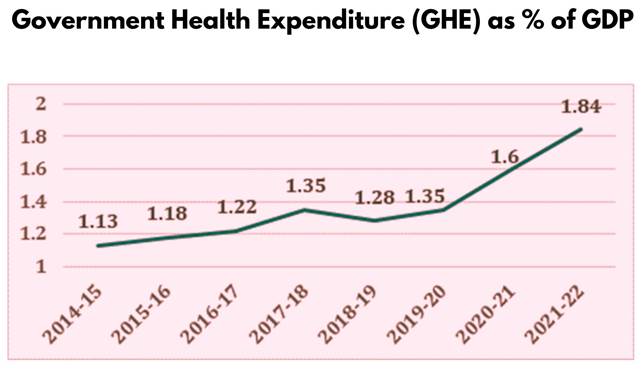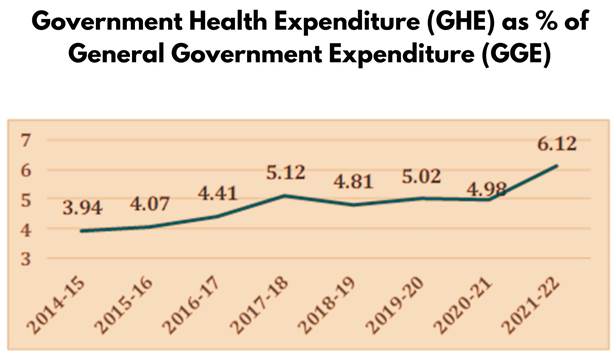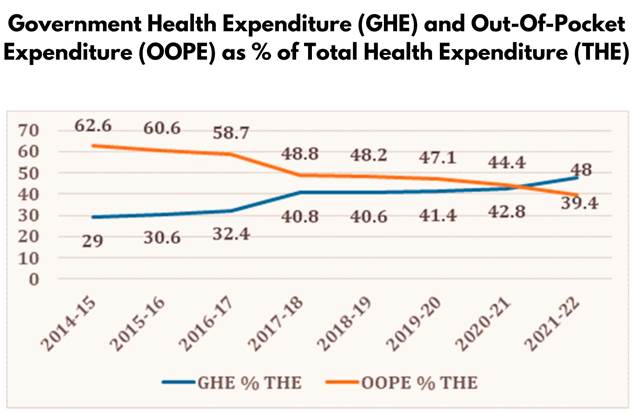Others
National Health Account (NHA) Estimates 2020-21 and 2021-22
A Comprehensive Overview
Posted On:
04 OCT 2024 12:08PM
The Union Ministry of Health and Family Welfare recently released the National Health Account (NHA) estimates for the fiscal years 2020-21 and 2021-22. These reports are the eighth and ninth editions of the NHA series, which provides a comprehensive view of the country’s healthcare expenditure. This document explores the key findings of the NHA estimates, underscoring significant trends such as increased government expenditure on healthcare, the decline in out-of-pocket expenses, and the growth in social security expenditure on health. As India continues its journey towards achieving Universal Health Coverage (UHC), these reports highlight the government's commitment to improving healthcare accessibility, reducing financial hardship, and enhancing public health infrastructure.
Key Findings of NHA Estimates for 2020-21 and 2021-22
- Rising Government Health Expenditure (GHE): Government spending on healthcare has seen a significant rise over the years. The share of Government Health Expenditure (GHE) in the GDP increased from 1.13% in 2014-15 to 1.84% in 2021-22. In terms of share in the General Government Expenditure (GGE), it has increased from 3.94% in 2014-15 to 6.12% in 2021-22. This growth highlights the government’s commitment to strengthening public healthcare services, especially in response to the challenges posed by the COVID-19 pandemic.

- In per capita terms, GHE has tripled, from Rs. 1,108 in 2014-15 to Rs. 3,169 in 2021-22. This indicates a substantial increase in healthcare investments, ensuring that more resources are available per person for healthcare services. The Government spending on health between 2019-20 and 2020-21 increased by 16.6%. Notably, there was a sharp rise in health expenditure between 2020-21 and 2021-22, with a 37% increase, marking the government’s proactive approach to managing the healthcare crisis during the pandemic.

- Decline in Out-of-Pocket Expenditure (OOPE): Out-of-Pocket Expenditure (OOPE) has traditionally been a significant burden on Indian households. However, between 2014-15 and 2021-22, the share of OOPE in the Total Health Expenditure (THE) declined from 62.6% to 39.4%. This reduction is a direct result of the government’s efforts to increase public health spending, improve access to healthcare, and reduce financial hardship for individuals seeking medical care.

- Increased Share of Government Health Expenditure in Total Health Expenditure: The government’s share in the Total Health Expenditure (THE) increased from 29% in 2014-15 to 48% in 2021-22. This shift indicates a greater reliance on public health services and a reduction in the financial burden on citizens. The rise in GHE reflects the government's focus on strengthening healthcare infrastructure, improving access to medical services, and enhancing financial protection.
- Growth in Social Security Expenditure (SSE) on Health: Another positive trend in the country’s health financing space is the increase in Social Security Expenditure (SSE). This increase in social security has a direct impact on reducing out-of-pocket payments. A robust social security mechanism ensures that individuals will not face financial hardship and the risk of poverty as a consequence of accessing essential healthcare services. The share of SSE on health, which includes government-funded health insurance, medical reimbursements to government employees, and social health insurance programs in the Total Health Expenditure, increased from 5.7% in 2014-15 to 8.7% in 2021-22.
- Total Health Expenditure in 2020-21: India's Total Health Expenditure (THE) was estimated at Rs. 7,39,327 crores, representing 3.73% of the GDP, with per capita spending of Rs. 5,436 in 2020-21. Total Health Expenditure includes both current and capital expenditures incurred by government and private sources, as well as external/ donor contributions. Of this, Current Health Expenditure (CHE) accounted for Rs. 6,63,417 crores (89.73% of THE), while capital expenditure stood at Rs. 75,910 crores (10.27% of THE). Government Health Expenditure (GHE), which includes capital expenditure, amounted to Rs. 3,16,554 crores, equating to 42.82% of THE, 1.60% of the GDP, and Rs. 2,328 per capita). This amounts to about 4.98 % of General Government Expenditure in 2020-21. The Union government’s contribution in GHE is about 35.7%, while state government’s share is about 64.3%. A significant portion of the Union Government’s expenditure was allocated to health schemes such as the National Health Mission and the Central Government Health Scheme.
- Total Health Expenditure in 2021-22: India's Total Health Expenditure rose to Rs. 9,04,461 crores, constituting 3.83% of GDP, with a per capita expenditure of Rs. 6,602 in 2021-22. Current Health Expenditure remained a major component, totaling Rs. 7,89,760 crores (87.32% of THE), while capital expenditure was at Rs. 1,14,701 crores (12.68% of THE). Government Health Expenditure saw a notable increase to Rs. 4,34,163 crores, covering 48% of THE and 1.84% of the GDP. This amounts to about 6.12% of General Government Expenditure in 2021-22. Government expenditures also witnessed broader distribution, with the Union Government accounting for 41.8% of GHE and state governments contributing 58.2%. The Union Government’s major health initiatives, including spending on the National Health Mission, Defense Medical Services, and the Central Government Health Scheme, remained crucial components of the expenditure framework.
- Distribution of Current Health Expenditure: The distribution of Current Health Expenditure (CHE) revealed that in 2020-21, the Union Government's share was Rs. 81,772 crores (12.33% of CHE), while state governments contributed Rs. 1,38,944 crores (20.94% of CHE). By 2021-22, the Union Government's CHE share had increased to Rs. 1,25,854 crores (15.94%), while the states' contribution was Rs. 1,71,952 crores (21.77%). Additionally, funding from enterprises, NGOs, and external donors provided crucial support to India's healthcare system during this period.
Implications of Increased Government Spending on Healthcare
The consistent increase in government health spending has multiple positive implications for the healthcare sector and the population at large:
- Reduction of Financial Hardships: The decline in OOPE reflects the government’s commitment to ensuring financial protection for citizens. By increasing public healthcare expenditure, the government has reduced the financial burden on households, making healthcare more accessible and affordable. This is particularly significant for low and middle-income families who may have previously faced financial barriers to seek medical care.
- Strengthening Public Healthcare Services: The rise in GHE demonstrates the government’s focus on improving healthcare infrastructure, expanding access to healthcare services, and enhancing the quality of care provided in public health institutions. Increased investments in healthcare have contributed to better-equipped hospitals, expanded vaccination programs, and improved preventive care services.
- Progress Towards Universal Health Coverage (UHC): The government’s efforts to increase healthcare spending are closely aligned with its goal of achieving Universal Health Coverage (UHC). By expanding public health programs, increasing the availability of health services, and reducing OOPE, the government is making significant strides toward ensuring that all citizens have access to affordable healthcare.
- Response to the COVID-19 Pandemic: The sharp increase in healthcare spending between 2020-21 and 2021-22 reflects the government’s proactive role in addressing the challenges posed by the COVID-19 pandemic. The additional resources allocated during this period were crucial in strengthening healthcare infrastructure, expanding testing and treatment facilities, and rolling out vaccination programs.
Understanding Health Accounts
Health Accounts describe health expenditures and flow of funds for a financial year in India. It answers important policy questions such as what the sources of healthcare expenditures are, who manages these, who provides healthcare services, and which services are utilized. It is a practice to describe the health expenditure estimates according to a global standard framework known as System of Health Accounts 2011 (SHA 2011), to facilitate comparison of estimates across countries. SHA 2011 framework presents expenditures disaggregated as Current and Capital expenditures. Focus is on describing Current Health Expenditures (CHE) and their details presented according to:
(1) Revenues of healthcare financing schemes – entities that provide resources to spend for health goods and services in the health system
(2) Healthcare financing schemes - entities receiving and managing funds from financing sources to pay for or to purchase health goods and services
(3) Healthcare providers - entities receiving finances to produce/provide health goods and services (4) Healthcare Functions - describe the use of funds across various health care services.
National Health Account
The National Health Account (NHA) estimates are structured based on the globally recognized framework known as the System of Health Accounts (SHA), 2011. This framework is essential for enabling inter-country comparisons, as it provides a standardized way to track and report on healthcare expenditures. The NHA offers a detailed description of the financial flows within India’s health system, illustrating how funds are collected from various sources, how they are spent across the healthcare sector, and how healthcare services are utilized.
India’s NHA estimates adhere to the National Health Accounts Guidelines for India, 2016, with necessary updates to reflect changes in the healthcare landscape. NHA guidelines/ methodology and estimates are continuously updated, as the Indian health system is dynamic and NHA estimates should reflect the changing policy/programmatic and health system context. Also, there is always potential for improvement related to the availability of data/ information or estimation methodology or revisions in the system of health accounts methods/framework or stakeholder feedback. These updates are a result of a thorough examination by the NHA team and the NHA Expert Group in consultation with competent authorities in this regard.
Conclusion
The National Health Account estimates for 2020-21 and 2021-22 provide valuable insights into India’s healthcare expenditure patterns and the government’s increasing investments in public health. The steady rise in government health expenditure, the decline in out-of-pocket payments, and the growth in social security spending all point to a more resilient and inclusive healthcare system.
As India continues to prioritize public health, these estimates highlight the government’s efforts to reduce financial barriers, improve healthcare infrastructure, and move towards achieving Universal Health Coverage. The ongoing reforms in the healthcare sector, backed by strong financial commitments, are paving the way for a healthier, more equitable future for all citizens.
References
https://pib.gov.in/PressReleasePage.aspx?PRID=2058791
https://nhsrcindia.org/national-health-accounts-records
https://nhsrcindia.org/sites/default/files/2024-09/NHA%202020-21.pdf
https://nhsrcindia.org/sites/default/files/2024-09/NHA%202021-22.pdf
Click here to see in PDF:
Santosh Kumar/ Sarla Meena/ Sheetal Angral/ Aswathy Nair
(Backgrounder ID: 153237)
Visitor Counter : 19912
Provide suggestions / comments